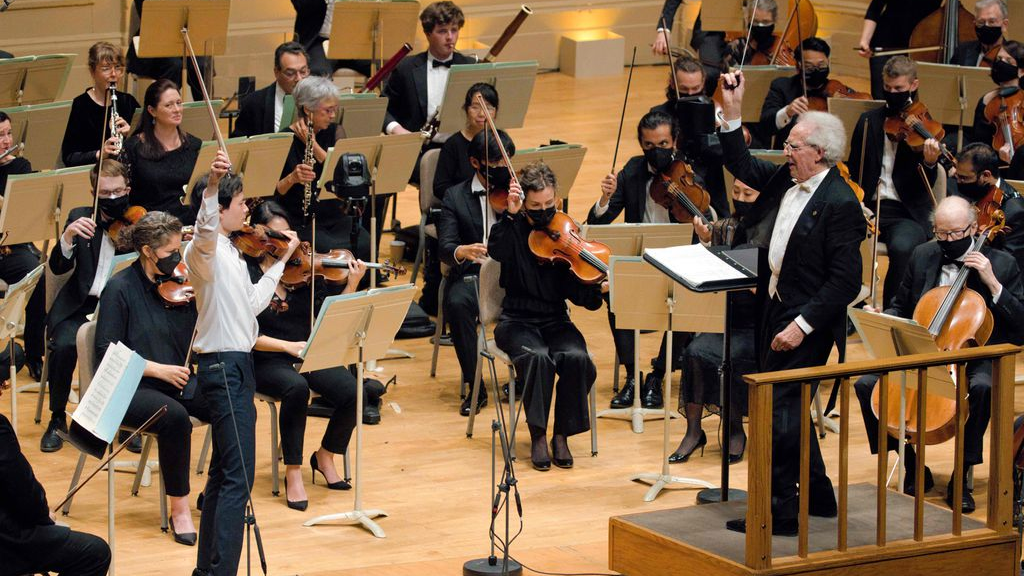The theme of the night at Boston Philharmonic’s second concert of the season? Excellence

Violinist Stefan Jackiw, music director Benjamin Zander, and orchestra brought vibrance, reverence to Symphony Hall
The program for the Boston Philharmonic Orchestra’s second concert of its 2021-22 season — Felix Mendelssohn’s “Hebrides” Overture, Sergei Prokofiev’s Violin Concerto No. 2, and Johannes Brahms’s Symphony No. 4 — didn’t have any obvious theme, but the excellence of the musicmaking at Symphony Hall on Wednesday was such that none was needed. BPO founder and music director Benjamin Zander was joined by Boston native and New England Conservatory graduate Stefan Jackiw, who was making his fourth appearance as a guest violinist with the orchestra, and whose previous performances of the Prokofiev include his Carnegie Hall mainstage debut in 2016.
The “Hebrides” Overture (also published under the title “Fingal’s Cave”) was inspired by Mendelssohn’s 1829 trip to a cave of basalt columns on the Inner Hebrides isle of Staffa. The score doesn’t call for much in the way of tempo changes, but its dynamic range suggests the composer experienced more than calm seas on his visit. Zander’s opening phrase was foreboding, and thereafter the moments of bright sunshine were quickly subsumed by howling winds and threatening clouds. You could hear gulls crying in the brass fanfares and then, when the second theme returned, seductive sirens in the tranquil clarinet duet of Rane Moore and Hunter Bennett. Eventually the tempest blew itself out, leaving Moore’s clarinet and Lisa Hennessy’s flute to meditate on the mystery that remained.
Prokofiev wrote his Second Violin Concerto for French violinist Robert Soetens in 1935. That was the same year he composed the initial version of “Romeo and Juliet,” and echoes of that ballet, particularly the love scenes, permeate the first two movements. The concerto premiered in Madrid, and key moments in the final movement are accompanied by castanets.
Jackiw and Zander built on the “Romeo and Juliet” connection with an intense, star-crossed reading. The obsessiveness of the opening phrase, which seems to be in 5/4 even though the time signature is 4/4, haunted the Allegro moderato first movement. Jackiw’s astringent tone and high-strung fiddling suggested the Montague-Capulet feud; then both soloist and orchestra relaxed into the dreamy, tango-tinged second subject.
The Andante assai began as a hypnotic processional, Jackiw spinning a long-breathed melody over pizzicato strings and winds. The melody grew waltzy, then impassioned; the orchestra throbbed, and there were glints of the “Dies irae” plainchant. At times Jackiw almost seemed to be improvising. Toward the end the sky darkened, and that led into the jagged, athletic Allegro finale, a spooky dance of death with more demonic fiddling from Jackiw. Percussionist Hans Morrison shone in the ominous violin and bass-drum duet, and Zander was careful to let both Morrison’s castanets and his closing triangle note be clearly audible.
Jackiw’s encore, the Largo from Bach’s C-major Violin Sonata, was both fluid and weighted. He made the bar lines disappear; over the piece’s three minutes, he all but made time disappear.
Brahms completed Symphony No. 4 in 1885, at a time when the composer was feeling pessimistic about the future of European culture and anxious about his own mortality. An autumnal work of reflection and perhaps regret, it begins seemingly in mid-walk, through chill gusts and swirling leaves, with French horns proclaiming the arrival of hunters. Poised at its organ-like outset between C major and E minor (belief and doubt?), the Phrygian-tinged Andante moderato appears to have wandered into one of Karl Friedrich Schinkel’s Gothic cathedrals. A harvest festival is in progress in the scherzo-like Allegro giocoso, which with its unusual 2/4 meter dances like a polka. The passacaglia finale is a theme and 30 eight-bar variations, Brahms having derived the theme from the final chaconne of Bach’s Cantata No. 150, “Nach dir, Herr, verlanget mich.”
The last time I heard Zander conduct the BPO in this symphony, in November 2011, his reading was more stormy than stoic. Wednesday’s first-rate performance took a similar approach, with vibrant fall colors and poignant prayer. Attention was paid to Brahms’s precise polyphony, his contrapuntal designs, his displaced rhythms and phrases, even his sly humor. The Andante moderato’s second subject was a hymn that rose to heights of Elgarian nobility before surging with anguish. The Allegro giocoso went at a rousing clip, with glowing brass and robust timpani.
The finale, marked Allegro energico e passionato, brought a surprise, Zander maintaining a steady pace throughout. Conductors traditionally slow down for Variations 12-15 because the meter changes from 3/4 to 3/2, but Zander’s cogent performance of this section supported his position that Brahms didn’t intend the tempo to change. Hennessy’s quicker traversal of the famous flute solo that is Variation 12 was a revelation; so were the flowing brass that started off Variation 14. At the end, too, Zander observed Brahms’s Piú allegro marking and abjured any final attempt at consolation, reminding us that the symphony concludes, as it began, in E minor.
Click here to listen to Brahms’ Fourth Symphony.
Click here to listen to a Concert Talk on Brahms’ Fourth Symphony.
 Jeffrey Gantz - The Boston Globe
Jeffrey Gantz - The Boston Globe